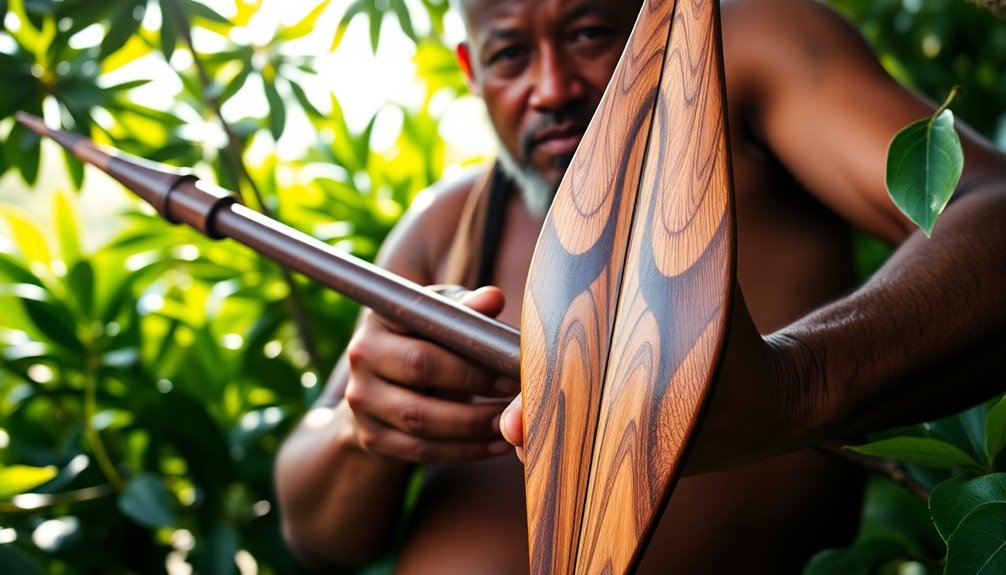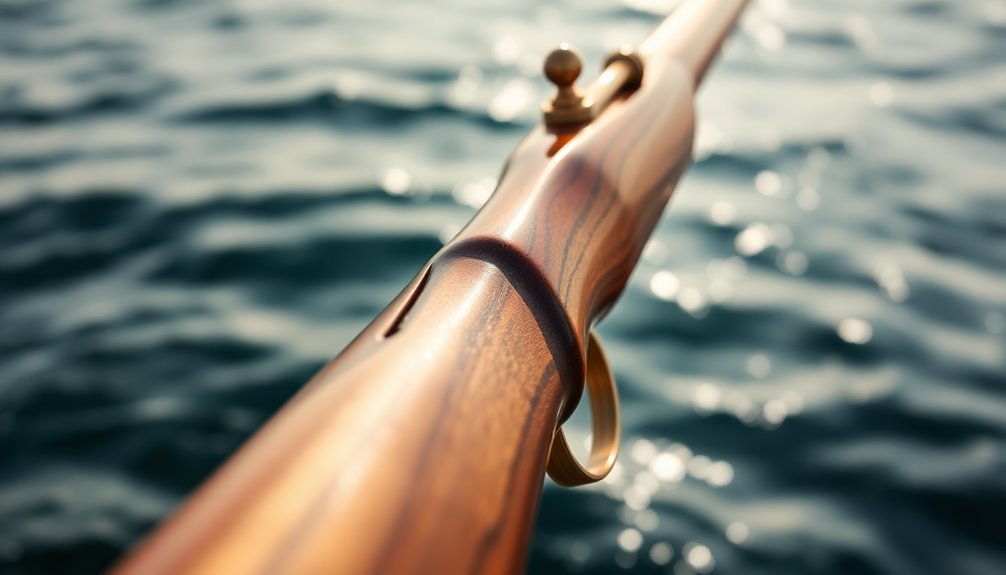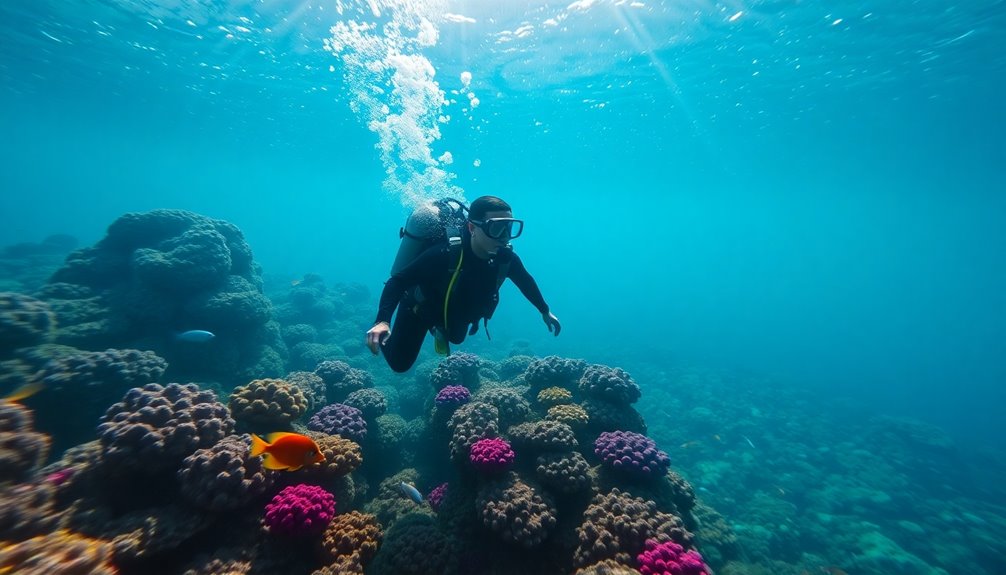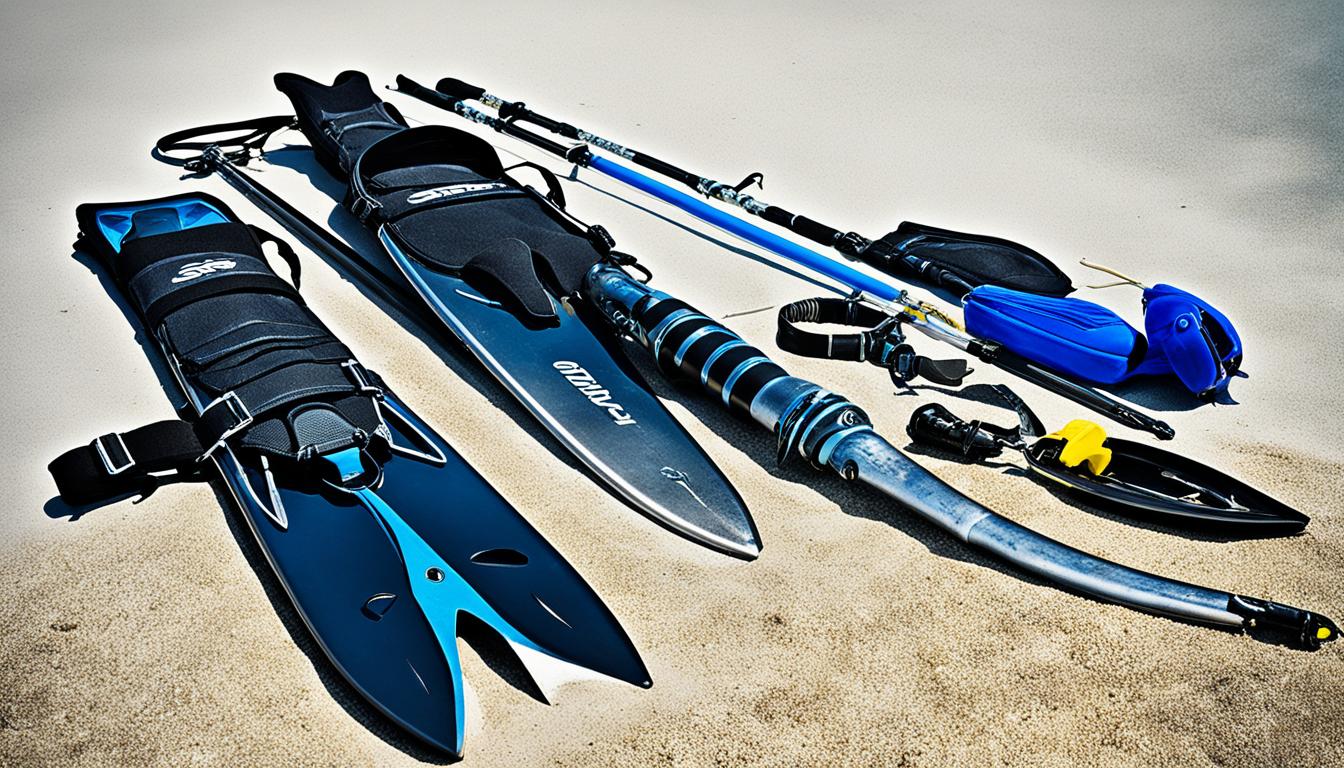The Hawaiian spear is a fascinating link to a rich tradition! Made from strong woods like *koa*, these spears come in two types: the long *pololu* for reaching far and the short *ihe* for close action. They're essential for spearfishing, mixing skill with respect for the ocean's spirits, where fish are seen as sacred. Learning to throw a spear involves proper stance, grip, and aim, which makes it exciting! Today, people celebrate this culture through games and ceremonies, keeping connections to their ancestors alive. Curious about how this tradition continues to thrive? You'll want to stick around to find out more!
Key Takeaways
- Hawaiian spears, crafted from durable hardwoods, reflect a rich cultural tradition emphasizing beauty and functionality in design.
- The long *pololu* and short *ihe* spears showcase unique techniques for different combat scenarios and spearfishing practices.
- Spearfishing traditions in Hawaii highlight respect for marine ecosystems and spiritual connections, honoring deities and ancestors through offerings.
- Historical figures like Kamehameha I utilized spear techniques in warfare, showcasing the importance of these weapons in unifying the Hawaiian Islands.
- Modern revivals of spear-throwing games and cultural ceremonies strengthen community bonds and celebrate Hawaiian heritage, connecting past traditions to contemporary practices.
Historical Context of the Hawaiian Spear

The Hawaiian spear has a rich historical context that reflects the ingenuity and resourcefulness of the islands' early inhabitants.
These remarkable weapons were crafted from strong woods like *kauila* and *koa*, which are as tough as they're beautiful. Imagine holding a spear made from a single piece of polished wood that shines like mahogany!
There are two main types of Hawaiian spears: the long spears called *pololu* and the shorter ones known as *ihe*.
The *pololu* can stretch from 3 to 6 meters long and was used in battles to trip opponents, while the *ihe* is shorter, perfect for close combat or throwing. The tips of these spears are often adorned with intricate barbs or polished points, showcasing the skill of the makers. Notably, the *ihe* features a tip with 5 rows of triple, faceted barbs, enhancing its effectiveness in battle.
Interestingly, some spears were even part of Captain Cook's historic voyages! They weren't just for show; warriors used them to defend against enemies or to throw at intruders.
Cultural Significance of Spearfishing

Spearfishing weaves a vibrant tapestry of cultural and spiritual significance in Hawaiian life. It's not just about catching fish; it's about connecting to the ocean and its wonders.
In Hawaiian culture, the ocean is seen as a spiritual realm, filled with fish that can represent deities. When you go spearfishing, you're participating in a tradition where fish are offered to ancestors and gods, like Ku'ula, the patron of fishing. This practice resonates with ancient practices that emphasized sustainability and respect for marine ecosystems. Additionally, the practice reflects a deep understanding of healthy ecosystems that is crucial for maintaining the balance of marine life.
But it goes beyond spirituality! Spearfishing is part of daily life, bonding communities and families. Many skills are passed from father to son or uncle to nephew, creating strong family ties.
Events like the father-son fishing tournament showcase this bond and the joy of fishing together.
Respecting the ocean is also super important. Traditional practices ensure that fish populations stay healthy, so there's plenty for future generations.
Traditional Spear-Throwing Practices

In Hawaiian culture, spear-throwing is more than just a skill; it's a vital practice rooted in history and tradition. When you stand to throw a spear, make sure your feet are shoulder-width apart, with your non-dominant foot pointing towards your target. Grip the spear like you're holding a giant pencil, lying flat in your hand.
As you angle your body slightly, pull the spear back behind you, extending your arm for extra power. Then, with a smooth motion, aim and launch! Release the spear when it's parallel to the ground, and remember, no sidearm throws!
Training is just as important. You'll want to practice in an open space, using safe, blunt-tipped spears. Stand at least 20 paces away from your partner, watching the spear's path to dodge or parry. In traditional practices, throwing spears are used to connect with the land and heritage, much like in Tiwi culture.
As you improve, get closer and learn to catch those spears!
Hawaiian warriors, like Kamehameha and Kekūhaupiʻo, showcased their skills in ceremonies and battles, passing down these techniques to the next generation.
Distinct Types of Hawaiian Spears

Distinct types of Hawaiian spears showcase the ingenuity and craftsmanship of the culture. There are two main categories: long spears, called *pololu*, and short spears, known as *ihe*.
Long spears measure between 12 to 15 feet and are designed for charging at opponents. They're not typically barbed but have sharp, blade-like points. Imagine a warrior skillfully holding it against their side, ready to trip an enemy or deliver a powerful thrust! The durability of these spears is enhanced by the use of strong hardwoods, which are essential for effective performance in battle.
On the other hand, short spears vary in length but are generally smaller than *pololu*. They often feature multiple barbs, which can help catch an opponent's spear or make a strong throw. You might picture a warrior using an underhand throw, hurling the spear with precision!
Sometimes, short spears have round or blade points instead of barbs, giving warriors different options during a battle.
Both types of spears are made from strong hardwoods like *kauila* and *koa*, which not only look beautiful when polished but also provide durability. The careful crafting and polishing of each spear reflect the importance of skill and tradition in Hawaiian culture.
Isn't it fascinating how each spear tells a story of bravery and craftsmanship?
Modern Revivals of Ancient Ceremonies

Hawaiian cultural practices surrounding spears extend far beyond ancient battles; they also encompass significant ceremonies that celebrate heritage and community. One exciting revival is the Kāli'i ceremony, which came back in 2017 after being gone for 200 years. This special event happened when the traditional voyaging canoe Hokule'a returned home. During the ceremony, they throw spears to see if a person has come back as a man or a god! Sam Kapoi, a crew member, bravely took on this challenge. The Kālii ritual, last performed by Kamehameha I, symbolizes a connection to cultural heritage and identity.
In addition to the Kāli'i ceremony, traditional Hawaiian games like spear tossing, known as Ōʻō Ihe, are also making a comeback. These games were essential for celebrations, showcasing strength and skill, much like the ancient Greek Olympics. King Kamehameha the Great even participated in an epic Ōʻō Ihe contest with seven spears thrown at him!
These modern revivals help preserve Hawaiian culture and connect families to their roots. By participating in these ceremonies and games, you can honor ancestors, celebrate community, and keep the spirit of aloha alive for future generations.
Symbolism in Hawaiian Mythology

Throughout history, symbols in Hawaiian mythology have played a crucial role in shaping cultural identity and spiritual beliefs. These symbols connect you to powerful gods and goddesses, like Ku, the god of war and prosperity, and Pele, the fiery goddess of volcanoes.
When you think of sea turtles, you're reminded of Kanaloa, the ocean god, who represents healing and strength. Isn't it amazing how these creatures serve as symbols of wisdom and protection? The presence of honu, or green sea turtles in Hawaiian waters also highlights their significance as a connection to the land and ocean.
The concept of 'aumakua, or ancestral spirits, is also fascinating. They can appear as animals, like sharks or owls, and act as family guardians. Imagine having a special shark watching over you, guiding and comforting you! It's a beautiful reminder of the connection between humans and nature.
Additionally, animistic beliefs show that everything around you, from stones to clouds, has a spirit. This idea emphasizes the importance of respecting nature and maintaining harmony.
The Role of Kamehameha I

Although many leaders have shaped Hawaiian history, Kamehameha I stands out for his remarkable ability to unify the islands. He was truly a master of military tactics!
Kamehameha saw that traditional Hawaiian warfare needed to change when guns and cannons arrived. He reorganized his army and trained his warriors in the new ways of battle, thanks to the help of European advisors. Imagine warriors practicing their drills, learning to use muskets, and even hiding their guns under mats and greenery—pretty clever, right? Kamehameha's leadership was marked by strategic battles aimed at unifying the Hawaiian Islands, with key conflicts including the Battle of Mokuʻōhai.
Kamehameha's efforts paid off during key battles. He defeated Keōua and took control of Hawaiʻi Island in 1792. His forces scored more victories at Iao Valley and Nuʻuanu Pali, where many enemies were cornered and forced over the cliff.
By 1810, he'd united all the islands into one royal kingdom!
Kamehameha also cared for his people. He created the Law of the Splintered Paddle to protect the vulnerable and promoted the production of fishing nets and canoes.
His legacy is one of strength, creativity, and unity, making him a beloved figure in Hawaiian history. Isn't that inspiring?
Impact on Contemporary Culture

Spearfishing holds a vital place in contemporary Hawaiian culture, weaving together threads of tradition, community, and spirituality. It's not just about catching fish; it's a way to connect with history and the ocean! When you dive in, you're also diving into stories passed down through generations, like the father-son fishing tournaments hosted by Alii Holo Kai, where families come together to celebrate this exciting tradition. In Hawaiian culture, the ocean is seen as a sacred place, filled with spiritual energy. Many spearfishers feel a special bond with their ancestors while they hunt, believing that every fish has a spirit. This connection makes the experience even more meaningful! You're not just fishing; you're honoring those who came before you. Moreover, the Hawaiian language revival has also played a significant role in fostering a deeper appreciation for traditional practices like spearfishing. Plus, spearfishing builds strong communities! Spearfishers share values about nature and conservation, often gathering for events that bring everyone closer. They work together to protect the reefs while enjoying the thrill of the catch.
Frequently Asked Questions
What Materials Are Traditionally Used to Make Hawaiian Spears?
When it comes to making Hawaiian spears, you'll find they're traditionally crafted from strong woods like Kauila and Koa. Kauila is dark and tough, while Koa is prized for its beauty!
Craftsmen also use solid hardwoods resembling mahogany. To make these spears even cooler, they add shark teeth or marlin bills for flair!
Sometimes, they weave loops from olona bark for grip. Isn't it awesome how these materials make the spears special?
How Has Modern Technology Influenced Spearfishing Practices in Hawaii?
Modern technology has really changed spearfishing in Hawaii!
With SCUBA gear, you can dive deeper and catch fish faster, but that also means larger fish, like groupers, are getting overfished.
Plus, new spearguns and pole spears are super powerful, making it easier to target those big fish!
While these advancements are exciting, it's important to remember to fish responsibly, so we don't run out of our ocean friends.
Happy spearfishing!
Are There Specific Rituals Associated With Modern Spearfishing?
Yes, there are specific rituals in modern spearfishing! Before you dive in, you might participate in a blessing ceremony to respect the ocean and its creatures.
Some fishers say a prayer or share stories that connect them to their ancestors.
After a successful catch, celebrating with friends and family is common, often sharing the fish as a meal.
These rituals keep the tradition alive and help you appreciate the beauty of nature!
What Role Do Women Play in Hawaiian Spearfishing Traditions?
In Hawaiian spearfishing traditions, women are stepping up and making waves!
While they used to be limited to foraging, now you'll find women diving, fishing, and even competing in tournaments.
Clubs like the Wahine Club encourage girls to join in, creating a tight-knit community.
Although they face some challenges, women prove their skills and earn respect, helping to pass on important cultural knowledge.
Isn't it exciting to see everyone working together in this vibrant tradition?
How Do Hawaiian Spearfishing Techniques Differ From Other Polynesian Cultures?
Hawaiian spearfishing techniques are super unique compared to other Polynesian cultures!
You often use methods like ambushing, where you hide and surprise fish, or active spearfishing, where you quietly glide along the seabed. These traditional methods of fishing require a great deal of skill and patience, but with the advancement of technology, underwater impact technology has become a popular tool for many fishermen. This innovative technology allows fishermen to not only catch more fish but also do so in a more efficient and sustainable way. With the use of underwater impact technology, fishermen can now target specific species and minimize the impact on the surrounding marine ecosystem.
While other cultures might use tools like Hawaiian slings or pole spears, you'll find that Hawaiian techniques blend tradition with modern innovations, like slip tips.
It's all about adapting to the ocean and having fun while fishing!
Conclusion
In conclusion, the Hawaiian spear isn't just a tool for fishing; it's a vibrant part of Hawaiian culture and history! From ancient times to today, it connects people with their roots and traditions. You've learned about its exciting uses, different types, and even its ties to legends like Kamehameha I. So, next time you see a Hawaiian spear, remember the stories and spirit behind each thrust. Isn't it amazing how a simple spear can hold so much meaning?










